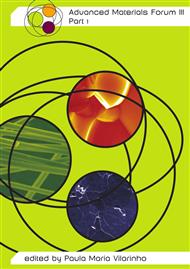p.1379
p.1385
p.1391
p.1396
p.1401
p.1409
p.1414
p.1419
p.1424
Modification of Organic Coatings with Thin Plasma Polymer Films. Influence on the Barrier Properties
Abstract:
Deposition of thin plasma polymer films as final layer on organic coatings can provide one promising solution to tailor the surface properties offering third functionality and increased mechanical properties. The present work is dedicated to the study of the barrier properties of polyurethane coil coatings modified by different plasma polymerization processes. Microwave (MW) and radio frequency (RF) plasmas were used to deposit thin films with different composition from various precursor mixtures. Transmission electron microscopy (TEM) and atomic force microscopy (AFM) were used to reveal the evolution of the plasma treated coil coatings during weathering tests. Electrochemical impedance spectroscopy (EIS) was employed to study the barrier properties of the coatings. The results show a degradation effect of the plasma treatment on the barrier properties of the coil coatings especially in the case of the oxygen-containing plasmas. However addition of a fluorinecontaining component to the precursor mixture leads to the elimination of the negative effect of the plasma treatment on the barrier properties of the coil coatings. The fluorine-containing films exhibit higher weathering stability in comparison with the fluorine-free ones.
Info:
Periodical:
Pages:
1401-1408
Citation:
Online since:
May 2006
Price:
Сopyright:
© 2006 Trans Tech Publications Ltd. All Rights Reserved
Share:
Citation:


